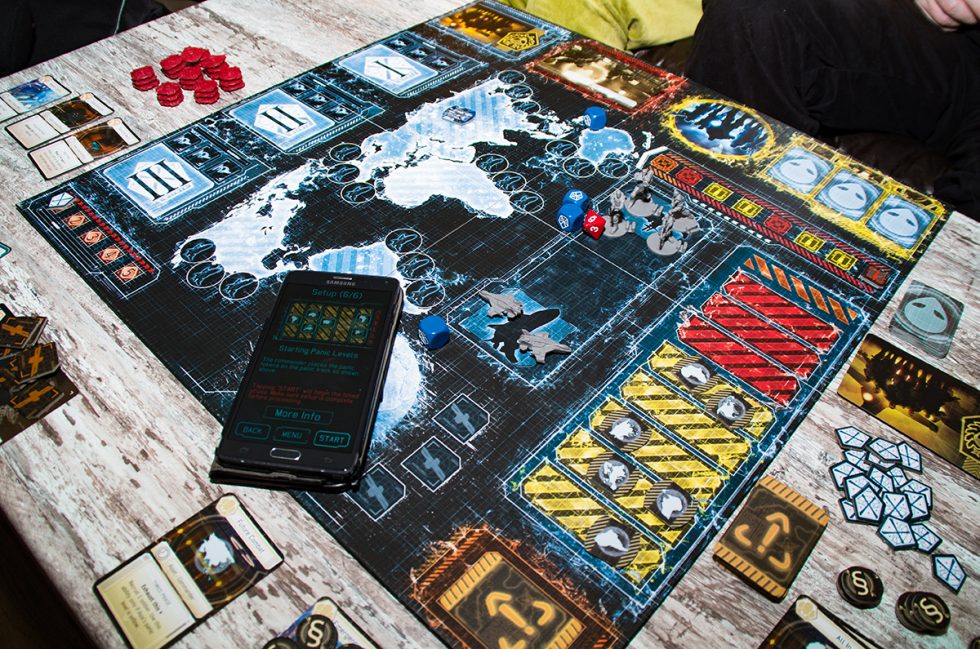Board gaming is in the midst of a creative “golden age.” But while games thrive on innovation, a paradoxically conservative streak runs through the hobby when it comes to the most fundamental technological shift of the 21st century: the rise of the smartphone.
While publishers have pushed out digital adaptations of hit games like Catan, Carcassonne, and Ticket to Ride, this is generally a one-way movement; few digital apps and tools are used in physical board games. But there are exceptions.
One of the first high-profile attempts at an analog-digital hybrid was XCOM: The Board Game. Released in 2015, the game offers a cooperative, multiplayer reimagining of the revered video game series that tasks players with repelling an alien invasion of the Earth. Created by Canadian designer Eric Lang, it uses a smartphone app to coordinate the aliens’ sinister plans to enslave the planet.
“I’d been wanting to do a digitally integrated game for years, but it wasn’t until smartphones with big screens really hit critical mass that the time was right to do it,” Lang told Ars. “And when the XCOM license came up, I just knew in my gut that this was the game to do it with. I’ve been a fan of the series since the beginning. Back in the '90s, my roommate had a copy and I remember thinking it looked a little primitive and kind of dumb, but when I actually played it I said, ‘My God, this is hard.’ I just died all the time.
“It was utterly compelling to me. I played it to the point where I even started dreaming about it.”

Lang’s previous credits include adaptations of big-name franchises like A Game of Thrones, Star Wars, and the Marvel comic book universe. Over the years, he has acquired a reputation as the go-to guy for tabletop translations that retain deep respect for the spirit of their source material. With XCOM, he distanced himself from the squad-based tactical gameplay portion of the original series, instead putting players in the shoes of top-level officers coordinating a global response to the alien threat.
“I didn’t want to just re-implement the video game as a board game. It would have felt like regurgitation,” he said. “So I thought: what if you could experience being the council, the people who are bossing the players around? What if you’re stuck in the situation room during the worst invasion of all time? I thought about real life disaster scenarios, and why the responses to big traumatic events usually break down. In 99 percent of cases it’s because you have smart, well-intentioned people sitting in a room arguing with limited time to make decisions. Eventually, someone has to make a call, and it’s usually the wrong call, and things fall apart after that.”
The XCOM board game uses a companion app to foster this sense of panic and chaos. The game divides each turn into two stages. First comes a timed round, with players racing against the clock to allocate their limited resources to the troops, air forces, and scientists under their command. At the same time, they must deal with a succession of randomized unfolding crises that threaten to derail their plans. It’s a recipe for acrimony, errors, and confusion, with players shouting over one another and arguing about which of the game’s escalating threats needs to be dealt with first.
“The core things I was looking for were frustration and stress, because that’s what hooked me into the video game in the first place,” said Lang. “The app lets me do that. I wanted to make something that really threatens players and hits them with the unknown. You know that there will be UFOs coming, but you don’t know exactly when or where they’re going to show up; you just have to be prepared. And if you play a purely analog cooperative game, there’s a lot of bookkeeping and responsibility that falls on the players. On every round, you’ll typically have to draw a card that’s going to screw with you in some way. But with the app handling all of that, you have this cold, distant enemy. Psychologically, it really feels like you’re fighting against this calculating, malicious foe.”
The app also adds to the game’s aesthetics. It comes with a tension-packed techno soundtrack, a science fiction-style user interface, and a news ticker at the bottom of the screen that shows stories about panic and unrest steadily mounting around the globe.
But even as XCOM embraces its digital element, it still relies on traditional mechanisms. After each smartphone-driven timed round comes a resolution phase, where players determine the outcome of the decisions they’ve just made. Players roll dice to decide the outcome of combat. They play ability cards to tilt the tide of events in their favor. They track stats using cardboard chips that progress along printed tracks on the game board.
“The key to XCOM is that, fundamentally, it’s a board game,” said Lang. “What the app is doing is taunting you and threatening you while you’re [playing].”
The blend of traditional tabletop elements and technological innovations seems to have struck a chord with players. XCOM received largely positive reviews on its release. While publisher Fantasy Flight Games doesn’t discuss sales numbers, Lang said that the title has sold “very well.”
reader comments
44